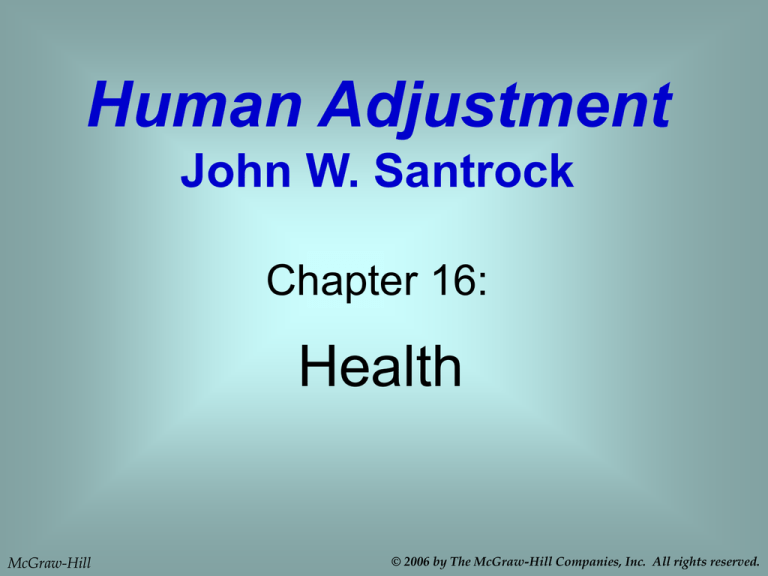
Human Adjustment
John W. Santrock
Chapter 16:
Health
McGraw-Hill
© 2006 by The McGraw-Hill Companies, Inc. All rights reserved.
16-2
Chapter Outline
Explaining Health and Illness
Nutrition and Eating
Exercise
Drugs and Addiction
The Patient and the Health-Care Setting
McGraw-Hill
©2006 by the McGraw-Hill Companies, Inc. All rights reserved.
16-3
Learning Goals
1. Describe some key factors in health and illness
2. Discuss nutrition, eating behavior, and eating
problems
3. Summarize the role of exercise in health
4. Explain drug use and addiction
5. Characterize some important aspects of the patient
and the health-care setting
McGraw-Hill
©2006 by the McGraw-Hill Companies, Inc. All rights reserved.
16-4
EXPLAINING HEALTH AND ILLNESS
The Bio-Psycho-Social Model
Psychological Factors in Health and Illness
Social Factors in Health and Illness
McGraw-Hill
©2006 by the McGraw-Hill Companies, Inc. All rights reserved.
16-5
The Bio-Psycho-Social Model
Bio-psycho-social model - health is best understood
in terms of a combination of biological, psychological,
and social factors
Biological
Psychological
Social
McGraw-Hill
©2006 by the McGraw-Hill Companies, Inc. All rights reserved.
16-6
Psychological Factors in Health and Illness
Psychological factors proposed as causes of health
problems include:
– lack of self-control
– emotional turmoil
– negative thinking
McGraw-Hill
©2006 by the McGraw-Hill Companies, Inc. All rights reserved.
16-7
Psychological Factors in Health and Illness
Positive emotional states are associated with health
patterns of physiological functioning in cardiovascular
system and immune system
– Positive emotions linked with release of secretory
immunoglobin A, antibody defense for common cold
Mood also influences people’s beliefs about their ability
to carry out health-promoting behaviors
McGraw-Hill
©2006 by the McGraw-Hill Companies, Inc. All rights reserved.
16-8
Social Factors in Health and Illness
Frequency and intensity of health problems vary
across cultures
Variations linked to cultural differences:
– social
– economic
– technological
– religious
– poor health care
McGraw-Hill
©2006 by the McGraw-Hill Companies, Inc. All rights reserved.
16-9
Social Factors in Health and Illness
Social factors that influence health:
– frequency of daily stressors
– unhealthy lifestyles
– poor health care
McGraw-Hill
©2006 by the McGraw-Hill Companies, Inc. All rights reserved.
16-10
Review - Learning Goal 1
– How is the bio-psycho-social model of health defined?
– What are some psychological influences on health?
– What are some social influences on health?
McGraw-Hill
©2006 by the McGraw-Hill Companies, Inc. All rights reserved.
16-11
NUTRITION AND EATING
Nutrition and Eating Behavior
Eating Problems
McGraw-Hill
©2006 by the McGraw-Hill Companies, Inc. All rights reserved.
16-12
The Food Guide Pyramid
The Food Guide Pyramid consists of recommended
daily servings of food, with an emphasis on consuming
more bread, cereals, rice, pasta, and vegetables than
milk, meats, fats, oils, and sweets
– The Food Guide is being revised by U.S. Department of
Agriculture
McGraw-Hill
©2006 by the McGraw-Hill Companies, Inc. All rights reserved.
Adjustment Strategies
for Eating Right
16-13
1. Study the Food Guide Pyramid and monitor
proposed changes in it
2. Follow a diet low in fat, saturated fat, and cholesterol
3. Substitute plenty of vegetables, fruits, and grain
products for unhealthy food
4. Use sugar only in moderation
5. Use sodium in moderation
6. Drink plenty of water
7. Eat breakfast every day
McGraw-Hill
©2006 by the McGraw-Hill Companies, Inc. All rights reserved.
16-14
Nutrition and Eating Behavior
– Cross-cultural study of women found strong correlation
between fat consumption and death rates from breast
cancer
– Food restriction in laboratory animals can increase the
animal’s lifespan
– Whether low-calorie diets can increase human lifespan is
not known
– Recent research suggests the possibility that some vitamin
supplements help slow the aging process and improve
health of older adults
McGraw-Hill
©2006 by the McGraw-Hill Companies, Inc. All rights reserved.
16-15
Obesity
Obesity is a serious and pervasive health problem for
many individuals
– Prevalence of obesity in U.S. adults is 25 percent
– Obesity is linked to increased risk of hypertension, diabetes,
and cardiovascular disease
Body mass index - measure of weight in relation to
height, used to determine whether an individual is
underweight, healthy weight, overweight, or obese
McGraw-Hill
©2006 by the McGraw-Hill Companies, Inc. All rights reserved.
16-16
Obesity
Factors likely involved in obesity include:
– heredity
– leptin
– set point and metabolism
– environmental factors
– ethnicity
– gender
McGraw-Hill
©2006 by the McGraw-Hill Companies, Inc. All rights reserved.
16-17
Heredity and Obesity
Some individuals inherit a tendency to be overweight
Animals can be inbred to be obese
Human twins have similar weights, even when they are
reared apart
McGraw-Hill
©2006 by the McGraw-Hill Companies, Inc. All rights reserved.
16-18
Leptin
Leptin = protein involved in satiety (condition of being
full to satisfaction) and released by cells resulting in
decreased food intake and increased energy
expenditure
Leptin acts as an anti-obesity hormone
McGraw-Hill
©2006 by the McGraw-Hill Companies, Inc. All rights reserved.
16-19
Leptin
In humans, leptin concentrations have been linked
with:
– weight
– percentage of body fat
– weight loss in a single diet episode
– cumulative percentage of weight loss in all diet episodes
McGraw-Hill
©2006 by the McGraw-Hill Companies, Inc. All rights reserved.
16-20
Set Point and Metabolism
Set point - weight maintained when no effort is made
to gain or lose weight
Fat is stored in adipose cells
When people gain weight, the number of their fat cells
increases
– Some scientists suggest these fat cells do not decrease
McGraw-Hill
©2006 by the McGraw-Hill Companies, Inc. All rights reserved.
16-21
Set Point and Metabolism
Basal metabolism rate (BMR) - minimal amount of
energy an individual uses in a resting state
– BMR decreases gradually during adulthood
Weight gain can be due to declining basal metabolism
rate
McGraw-Hill
©2006 by the McGraw-Hill Companies, Inc. All rights reserved.
16-22
Environmental Factors in Obesity
Our earliest ancestors probably developed preference
for sweets because ripe fruit was accessible
The dramatic increase in rate of obesity in the United
States is likely due to greater availability of food,
energy-saving devices, and declining physical activity
Sociocultural factors are involved in obesity, which is
six times more prevalent among women with low
incomes
McGraw-Hill
©2006 by the McGraw-Hill Companies, Inc. All rights reserved.
16-23
Dieting and Obesity
Many Americans are obsessed with dieting
Restrained eaters - individuals who chronically restrict
food intake to control their weight
– Restrained eaters are often on diets, very conscious of what
they eat, and feel guilty after splurging on sweets
Many Americans regularly start diets, but few are
successful in keeping weight off
McGraw-Hill
©2006 by the McGraw-Hill Companies, Inc. All rights reserved.
16-24
Dieting and Obesity
Current hot trend is low-carbohydrate diet promoted
by Robert Atkins
Short-term - individuals on low-carbohydrate diet do
lose weight
Long-term - studies not yet done
– Atkins diet may pose health risks - foods high in fats
increase risk of heart disease and cancer-food restricted
reduce heart disease, cancer and other diseases
Weight cycling (yo-yo dieting) is linked with some
chronic diseases
McGraw-Hill
©2006 by the McGraw-Hill Companies, Inc. All rights reserved.
16-25
Adjustment Strategies for Losing Weight
1. Exercise regularly
2. Keep a food diary
3. Shop from a list and don’t shop when hungry
4. Minimize exposure to food cues
5. Use smaller plate with smaller servings
6. Eat at the table with the TV off
7. At restaurants, eat only half your meal
8. Don’t starve yourself all day and then eat one big
meal in the evening
9. Seek support from family and friends
10. Be realistic about weight loss goals
McGraw-Hill
©2006 by the McGraw-Hill Companies, Inc. All rights reserved.
16-26
Anorexia Nervosa
Anorexia nervosa = eating disorder that involves
relentless pursuit of thinness through starvation
Anorexia typically begins in teenage years
Ten times more likely to affect females
McGraw-Hill
©2006 by the McGraw-Hill Companies, Inc. All rights reserved.
16-27
Anorexia Nervosa
Characteristics of anorexia nervosa include:
– weighing less than 85% of what is considered normal
– having intense fear of gaining weight
– having a distorted image of body
McGraw-Hill
©2006 by the McGraw-Hill Companies, Inc. All rights reserved.
16-28
Bulimia Nervosa
Bulimia nervosa = eating disorder in which individual
consistently follows a binge-and-purge eating pattern
A Bulimic goes on an eating binge and then purges by
self-induced vomiting or use of a laxative
– 90% of bulimics are women
McGraw-Hill
©2006 by the McGraw-Hill Companies, Inc. All rights reserved.
16-29
Bulimia Nervosa
Most bulimics are:
– preoccupied with food
– have strong fear of becoming overweight
– are depressed or anxious
McGraw-Hill
©2006 by the McGraw-Hill Companies, Inc. All rights reserved.
16-30
Review - Learning Goal 2
– What is the Food Guide Pyramid and how is it changing?
What are some cultural variations in eating behavior? What
are some links between nutrition and longevity?
– What characterizes obesity and dieting? What are anorexia
nervosa and bulimia nervosa?
McGraw-Hill
©2006 by the McGraw-Hill Companies, Inc. All rights reserved.
16-31
EXERCISE
The Benefits of Exercise
Exercise and Longevity
McGraw-Hill
©2006 by the McGraw-Hill Companies, Inc. All rights reserved.
16-32
The Benefits of Exercise
Aerobic exercise = sustained exercise that
stimulates heart and lung activity
Exercise helps to prevent
heart disease
McGraw-Hill
©2006 by the McGraw-Hill Companies, Inc. All rights reserved.
16-33
The Benefits of Exercise
Regardless of other risk factors (smoking, high blood
pressure, overweight, heredity), if you exercise enough
to burn over 2,000 calories a week you can cut risk of
heart attack by two-thirds
Health experts recommend at least 30 minutes of
moderate-intensity physical activity a day
McGraw-Hill
©2006 by the McGraw-Hill Companies, Inc. All rights reserved.
16-34
The Benefits of Exercise
Exercise also benefits mental health:
– improves self-concept
– reduces anxiety
– reduces depression
McGraw-Hill
©2006 by the McGraw-Hill Companies, Inc. All rights reserved.
16-35
Exercise and Longevity
Regular exercise can lead to healthier life as a middleaged and older adult and increase longevity
Gerontologists recommend strength training in addition
to aerobic activity and stretching for older adults
– Weight-lifting can preserve and
possibly increase muscle mass
in older adults
McGraw-Hill
©2006 by the McGraw-Hill Companies, Inc. All rights reserved.
16-36
Exercising and Aging
Conclusions on exercise and aging:
– can influence physiological changes in brain tissue
associated with aging
– can optimize body composition
– is related to prevention of chronic diseases
– is associated with improvement in many diseases
– is related to prevention of disability
– can be used to counteract side-effects of standard medical
care
– is linked to increased longevity
McGraw-Hill
©2006 by the McGraw-Hill Companies, Inc. All rights reserved.
Adjustment Strategies
for Exercising Regularly
16-37
1. Consult with your doctor and get a physical exam
2. Make exercise a high priority in your life
3. Reduce TV time
4. Chart your progress
5. Get rid of excuses
6. Learn more about exercise
McGraw-Hill
©2006 by the McGraw-Hill Companies, Inc. All rights reserved.
16-38
Review - Learning Goal 3
– What is aerobic exercise? What are the benefits of
exercise?
– What is the connection between exercise and longevity?
McGraw-Hill
©2006 by the McGraw-Hill Companies, Inc. All rights reserved.
16-39
DRUGS AND ADDICTION
Psychoactive Drugs
Addiction
Alcohol
Smoking
McGraw-Hill
©2006 by the McGraw-Hill Companies, Inc. All rights reserved.
16-40
Psychoactive Drugs
Psychoactive drugs = substances that act on the
nervous system to alter states of consciousness,
modify perceptions, and change moods
McGraw-Hill
©2006 by the McGraw-Hill Companies, Inc. All rights reserved.
16-41
Psychoactive Drugs
Psychoactive drugs have been classified into three
main categories:
– Depressants - drugs that slow down the nervous system,
body functions, and behaviors
– Stimulants - drugs that increase activity of the nervous
system
– Hallucinogens - drugs that modify an individual’s
perceptual experiences and produce hallucinations
McGraw-Hill
©2006 by the McGraw-Hill Companies, Inc. All rights reserved.
16-42
Addiction
Psychological dependence = person is
preoccupied with a drug for emotional
reasons (such as reduction of stress)
Physical dependence = discontinuing use
of a drug creates unpleasant, significant
changes in physical functioning and
behavior
McGraw-Hill
©2006 by the McGraw-Hill Companies, Inc. All rights reserved.
16-43
Addiction
Withdrawal changes can include:
– insomnia
– tremors
– nausea
– vomiting
– cramps
– elevation of heart rate and blood pressure
– convulsions
– anxiety
– depression
McGraw-Hill
©2006 by the McGraw-Hill Companies, Inc. All rights reserved.
16-44
Models of Addiction
Disease model of addiction - addictions are
biologically based, lifelong diseases that involve loss of
control over behavior and require medical and/or
spiritual treatment for recovery
– Disease model supported by medical profession and
Alcoholics Anonymous (AA)
McGraw-Hill
©2006 by the McGraw-Hill Companies, Inc. All rights reserved.
16-45
Models of Addiction
Life-process model of addiction - addiction is a
habitual response and a source of gratification or
security that can be understood best in the context of
social relationships and experiences
McGraw-Hill
©2006 by the McGraw-Hill Companies, Inc. All rights reserved.
16-46
Alcohol
Alcohol acts on the body as a depressant
Approximately 1.4 million people in United States are
alcoholics
McGraw-Hill
©2006 by the McGraw-Hill Companies, Inc. All rights reserved.
Drinking in College Students
and Young Adults
16-47
Almost half of college binge drinkers reported problems
that include:
– missing classes
– physical injuries
– trouble with police
Rate of binge drinking is about 44 percent
By the time individuals reach mid-20s, many have
reduced their use of alcohol
McGraw-Hill
©2006 by the McGraw-Hill Companies, Inc. All rights reserved.
16-48
Alcoholism
Alcoholism = disorder that involves long-term, repeated,
uncontrolled, compulsive, and excessive use of
alcoholic beverages and that impairs the drinker’s
health and social relationships
McGraw-Hill
©2006 by the McGraw-Hill Companies, Inc. All rights reserved.
16-49
Alcoholism
Both genetic and environmental factors play a role in
alcoholism
– Heredity likely plays a role in half of the cases of alcoholism
About one-third of alcoholics recover
McGraw-Hill
©2006 by the McGraw-Hill Companies, Inc. All rights reserved.
Adjustment Strategies
for Curbing Alcohol Use
16-50
1. Admit you have a problem
2. Write down your reasons for cutting down your
drinking
3. Set a drinking goal and keep a diary
4. Don’t ignore what others are saying to you
5. Don’t go out with others who make you feel
uncomfortable if you are not drinking
6. Don’t keep beer, wine, or hard liquor at home
7. Seek help for your problem
McGraw-Hill
©2006 by the McGraw-Hill Companies, Inc. All rights reserved.
16-51
Smoking
Smoking is linked to
– 30% of cancer deaths
– 21% of heart disease deaths
– 82% of chronic pulmonary disease deaths
Most adult smokers would like to quit, but their
addiction to nicotine makes quitting a challenge
McGraw-Hill
©2006 by the McGraw-Hill Companies, Inc. All rights reserved.
Adjustment Strategies
for Quitting Smoking
16-52
1. Develop a strong self-motivation to quit
2. Use a substitute source of nicotine
3. Take the antidepressant Bupropion ST (Zyban)
4. Control stimuli associated with smoking
5. Undergo aversive conditioning
6. Go “cold turkey”
7. Stay smoke-free
McGraw-Hill
©2006 by the McGraw-Hill Companies, Inc. All rights reserved.
16-53
Review - Learning Goal 4
– What are psychoactive drugs? What are the three main
classifications of psychoactive drugs?
– What is addiction? What are two models of addiction?
– What is the effect of alcohol use, and how extensive is it?
What is alcoholism?
– What are the effects of smoking cigarettes, and how
extensive is cigarette smoking in the United States? How
effective are strategies for quitting smoking?
McGraw-Hill
©2006 by the McGraw-Hill Companies, Inc. All rights reserved.
THE PATIENT AND THE
HEALTH-CARE SETTING
16-54
Recognizing and Interpreting Symptoms
Seeking Treatment
The Patient’s Role
Adherence to Medical Advice and Treatment
Socioeconomic Status and Ethnicity
Gender
McGraw-Hill
©2006 by the McGraw-Hill Companies, Inc. All rights reserved.
16-55
Recognizing and Interpreting Symptoms
Many people are not very accurate at recognizing they
have symptoms of an illness
– People are better at recognizing symptoms of illnesses they
are familiar with than illnesses they are less familiar with
We use schemas (organized ways of looking at things
that influence our expectations) to interpret information
about ourselves in our world
– Prior experience is often used to interpret
McGraw-Hill
©2006 by the McGraw-Hill Companies, Inc. All rights reserved.
16-56
Seeking Treatment
Whether or not we seek treatment for symptoms
depends on our perception of their severity and of the
likelihood that medical treatment will relieve or
eliminate them
When people direct their attention outward, they are
less likely to notice symptoms than when they direct
their attention inward
– Belief systems influence our response to symptoms
McGraw-Hill
©2006 by the McGraw-Hill Companies, Inc. All rights reserved.
16-57
The Patient’s Role
Shelley Taylor (1979) identified two general types of
patient roles:
– “good patient” role - patient who is passive and
unquestioning and behaves properly
– “bad patient” role - patient who complains to staff,
demands attention, disobeys staff orders, and generally
misbehaves
Realistic expectations about the hospital experience,
predictable events, and social support reduce the
stress of hospitalization
McGraw-Hill
©2006 by the McGraw-Hill Companies, Inc. All rights reserved.
Adherence to Medical Advice
and Treatment
16-58
One-third of patients fail to follow recommended
treatments
– Adherence depends on the disorder and the
recommendation
Success or failure in treatment may depend on
whether the doctor can convince patients that a valid,
believable danger exists and can offer an effective,
concrete strategy for coping with the problem
McGraw-Hill
©2006 by the McGraw-Hill Companies, Inc. All rights reserved.
16-59
Socioeconomic Status and Ethnicity
Individuals from low socioeconomic status
backgrounds use medical services less than
individuals from middle and high socioeconomic status
backgrounds
– Many individuals living in poverty do not receive regular
medical care
McGraw-Hill
©2006 by the McGraw-Hill Companies, Inc. All rights reserved.
16-60
Socioeconomic Status and Ethnicity
Language is often a barrier for unacculturated Latinos
in doctor-patient communication
Depending on the degree of acculturation to Western
society, Chinese Americans might go to either a folk
healer or a Western doctor for care
Mexican Americans rely on family members to make
decisions, and cannot make a quick decision when
asked by a doctor
McGraw-Hill
©2006 by the McGraw-Hill Companies, Inc. All rights reserved.
16-61
Socioeconomic Status and Ethnicity
Health-care professionals can increase effectiveness
with ethnic minority patients by:
– improving their knowledge of patients’ attitudes, beliefs, and
folk practices regarding health and disease
McGraw-Hill
©2006 by the McGraw-Hill Companies, Inc. All rights reserved.
16-62
Gender
Special concerns about women’s health focus on:
– unintended and unwanted pregnancy
– abuse and violence
– AIDS
– role of poverty in women’s health
– eating disorders
– drug abuse
– breast diseases
– reproductive health
– discrimination of medical establishment against women
McGraw-Hill
©2006 by the McGraw-Hill Companies, Inc. All rights reserved.
16-63
Gender
In one study, physicians described men and women
patients differently:
– men - characterized as direct, logical, good decision
makers, and rarely emotional
– women - characterized as excitable in minor crises, more
easily influenced, less adventurous, less independent, and
illogical
Most medical research has been done with men, and
results generalized to women without justification
McGraw-Hill
©2006 by the McGraw-Hill Companies, Inc. All rights reserved.
16-64
Review - Learning Goal 5
– How good are individuals at recognizing and interpreting
symptoms?
– What factors influence whether individuals seek treatment?
– What are “good patient” and “bad patient” roles?
– To what extent do individuals adhere to medical advice and
treatment?
– What roles do socioeconomic status and ethnicity play in
health care?
– How is gender involved in the health-care system?
McGraw-Hill
©2006 by the McGraw-Hill Companies, Inc. All rights reserved.
16-65
End of Chapter 16
McGraw-Hill
©2006 by the McGraw-Hill Companies, Inc. All rights reserved.









